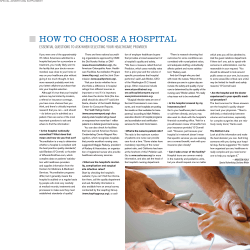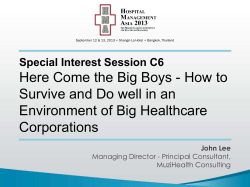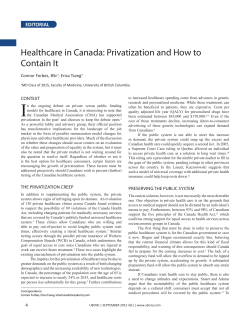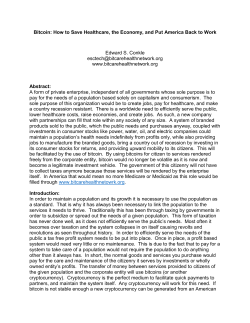
12. HOW TO APPROACH CLINICAL PRACTICE IMPROVEMENT AND DEPARTMENTS
THE BEST OF HMA An e-collection of 15 of the highest rated presentations from HMA 2008 to 2012 12. HOW TO APPROACH CLINICAL PRACTICE IMPROVEMENT AND WHY IT AFFECTS ALL HOSPITAL DEPARTMENTS Nellie Yeo Consultant, Asia Pacific, Joint Commission International Presented in HMA 2009 Hospital Management Asia 13 August 2009 Ho Chi Minh City, Vietnam Nellie Yeo, MN, MBA, CPHQ Consultant, Joint Commission International © Copyright, Joint Commission International How to approach Clinical Practice Improvement and why it affects all Hospital Departments – JCI and its mission – QPS standards focus on training and improvement activities across all departments – History of Healthcare Quality and Model of Improvement – How do You begin ? – Key ingredients for Success © Copyright, Joint Commission International Presentation Outline – Set optimum, achievable expectations – Focus on the patient – Designed to be interpreted/surveyed within the local culture and legal framework – Stimulates continuous improvement © Copyright, Joint Commission International Joint Commission International Standards Accredited Organizations in Asia-Pacific Region 1 4 10 2 5 5 3 15 1 48 organizations accredited (19%) © Copyright, Joint Commission International 2 – Introduction of JCI and its mission – QPS standards focus on training and improvement activities across all departments – History of healthcare quality and Model of Improvement – How do You begin ? – Key ingredients for success © Copyright, Joint Commission International Purpose of the Presentation – There is a training program for staff that is consistent with their role in the Quality Improvement and Patient Safety program – A knowledgeable individual provides the training – Staff members participate in the training as part of their regular work assignment QPS.1.5 © Copyright, Joint Commission International Staff Training – The organization plans and implements improvements using a consistent process selected by the leaders – The organization documents the improvements achieved and sustained QPS.8 © Copyright, Joint Commission International Consistent Process – The priority areas identified by the leaders are included in improvement activities – Human and other resources are assigned or allocated – Changes are planned and tested – Changes are implemented – Data are available to demonstrate that improvements are effective and sustained – Policy changes necessary are made – Successful improvements are documented QPS.9 © Copyright, Joint Commission International Improvement Activities – Introduction of JCI and its mission – QPS standards focus on training and improvement activities across all departments – History of Healthcare Quality and Model of Improvement – How do You begin ? – Key ingredients for success © Copyright, Joint Commission International Purpose of the Presentation How quality made its way into healthcare Scientific Management (~1911: Frederick Taylor et al.) Statistical process control (~1931: Walter Shewhart) Quality improvement - PDSA cycle (~1955: W. Edwards Deming et al.) © Copyright, Joint Commission International Quality Management – Pareto Principle (~1951 : Joseph Juran) Lean or "pull" production (~1990: Womack et al.) Statisticians develop & document QI methods since 1950s Edwards Deming "It is not enough to just do your best or work hard. You must know what to work on” © Copyright, Joint Commission International – PDCA cycle – Continuous Improvement Modern Day Quality Guru Dartmouth Medical School (~1980: Paul Batalden) Intermountain Healthcare (~2000: Brent C James) © Copyright, Joint Commission International Institute of Healthcare Improvement (~1990: Don Berwick) The Model of Improvement Principles of Improvement All improvement is local To improve, you have to change Not all change leads to improvement What is the Problem ? Too many different improvement initiatives / packages Search for magic pill Not prepared for a long term fight Even fewer ideas worked meaningfully to gain significant leverage hospital wide © Copyright, Joint Commission International No traction and results not sustained What are You missing? Enculturalization : clinicians not onboard Lack of concerted effort to first engage the Clinicians Complex tools & concepts introduced – clinicians are not QI experts Localized change is necessary © Copyright, Joint Commission International Different levels of maturity Leadership Building the WILL to change Generating the opportunities and ideas for change Giving permission to change Providing the resources and incentives EXECUTING changes to the system © Copyright, Joint Commission International Creating and Communicating a VISION for change Essential Elements Governance Measurement Improvement Culture © Copyright, Joint Commission International Leadership Tactics of Change Management Problems can only be solved where they reside Need to speak in the language of healing professions Need to see their involvement at a personal level by strengthening their resolve Seeing innovation as part of the re-design process © Copyright, Joint Commission International Simple and easy to learn & apply How to plant the seeds for Change? Creating in them a notion of dissatisfaction with the status quo in patient outcomes Every system is perfectly designed to do the things they do © Copyright, Joint Commission International Discover change is easy & possible, and most problems are found in systems, not people. – Introduction of JCI and its mission – QPS standards focus on training and improvement activities across all departments – History of healthcare quality and Model of Improvement – How do You begin ? – Key ingredients for success © Copyright, Joint Commission International Purpose of the Presentation How do You begin ? Go and see for yourself Undertake a 6 months learning project and see it through from start to end (learning by doing) © Copyright, Joint Commission International Teach them easy and applicable basic tools to make change How do You begin ? Using the best clinical evidence (where available) to re-design the care delivery Pilot your improvement in a small area Try storming till results affect positive outcomes © Copyright, Joint Commission International With a multi-disciplinary team approach Major Quality Improvement (QI) Solutions CPIP teaches the foundations of QI to clinicians CPIP – education tool that focuses on improving clinical care through best evidence via a multi-disciplinary team Evidence of problem Diagnostic Journey Planned Intervention Run Chart Sustain Improved clinical care for patients Lean - focuses on dramatically improving flow in the value stream and eliminating waste Specify Value Understand Demand Flow Level Perfection Improved Efficiency & Speed Six Sigma - focuses on eliminating defects and reducing variation in processes Define Measure Analyze Improve Control Improved Effectiveness How CPI does improvement …a few simple steps to success Mission Statement Evidence of problem worth Solving Team Members 1. The Problem Customer patient feedback Cause & Effect Diagram Pareto Chart 2. Diagnostic Journey Interventions PDSA Cycles Run Chart 3. Interventions & Run Chart Cost Savings Strategy for Sustaining 4. Holding the gains © Copyright, Joint Commission International Flow chart of process Mission statement Project team Ongoing monitoring Outcomes Sustaining Improvement 5 Annotated run chart SPC charts Impact Project 1 2 Diagnostic 4 3 Journey Conceptual Flow of process Customer Grid Data - Fishbone - Pareto chart - Run charts -SPC charts Intervention Plan a change Do it in a small test Study its effects Act on the results © Copyright, Joint Commission International Future plans Small Cycles of Improvement Change that results in improvement Implementation of change Wide scale tests of change Hunches theories ideas A P S D Follow up tests Very small scale test © Copyright, Joint Commission International A P S D What are the Components for Change? Plant the seed (engage clinicians) In a fertile field (positive culture) Water (basic tools) Sunshine (more complex tools) Scatter seeds properly (spreading ideas) © Copyright, Joint Commission International Lay compost (support & facilitation) Target: senior clinicians As of Jan 09, 19 cycles of CPIP have been conducted over 7 years, training a total of 734 NHG staff – especially the target group of senior clinicians CPIP Numbers trained - At a glance 400 22.6 % CMBs and HODs 350 Staff Trained 300 250 200 150 9.3 % DONs & ADONs 275 AC and above 108 100 NO and above 11.2 % HODs 3.3 % HODs 16.7 % HODs 50 74 83 92 90 12 0 Doctors Nurses Allied Dentists Admin 349 Doctors trained making 47% of the entire pool trained (include 62 at level of CMBs, Division or Department Chiefs or Heads) 191 Nurses, 104 Allied Health & Dentists and 90 Administrative Staff © Copyright, Joint Commission International IMPACT: various staff various departments – Introduction of JCI and its mission – QPS standards focus on training and improvement activities across all departments – History of healthcare quality and Model of Improvement – How do You begin ? – Key ingredients for Success © Copyright, Joint Commission International Purpose of the Presentation Key ingredients for Success Maintain communications (team, facilitator, sponsor) Link to organizational priorities (far higher chance of greater success) Bite off what you can chew (focus on changes you can make quickly) Fix obvious problems first Look upstream, and downstream Document progress & problems (so that you can duplicate success for organisation memory) Monitor changes ; Publicize and celebrate success (early success fuels the work for next steps in journey of improvement) © Copyright, Joint Commission International (mentally walk through entire process ,problems may be buried in there) The greatest danger for most of us lies not in setting our aim too high, but in setting our aim too low and achieving our mark. © Copyright, Joint Commission International Michelangelo © Copyright, Joint Commission International © Copyright, Joint Commission International Never tested on how well we can work with each other ….. The best interest of the patient is the only interest to be considered, and in order that the sick may have the benefit of advancing knowledge, union of forces is necessary. . . It has become necessary to develop medicine as a cooperative science. © Copyright, Joint Commission International Dr. William J. Mayo "Genius is one percent inspiration, ninety-nine percent perspiration." - Thomas Alva Edison, Harper’s Monthly (September 1932) © Copyright, Joint Commission International 1000 ways how not to make a light bulb © Copyright, Joint Commission International Door2Balloon © Copyright, Joint Commission International to begin Your journey? Ready Acknowledgements & References – The TeamHandbook, 3rd Ed,Peter Scholtes, Brian L. Joiner, Barbara J. Streibel, Madison, Oriel, 2003 – The Improvement Guide, Langley, Gerald, Kevin Nolan, Thomas Nolan, Cliff Norman, and Lloyd Provost; San Francisco, CA; Jossey-Bass, 1996 – Dr Brent James, ITC – Dr Ross Wilson, NYCHHC – National Healthcare Group CPIP Faculty and Facilitators – www.ihi.org/IHI/Programs/Campaign/ © Copyright, Joint Commission International – Donald M. Berwick, MD, MPP; Institute for Healthcare Improvement Grazie. Do jeh Tak 당신을 감사하십시오 tesekkür ederim © Copyright, Joint Commission International 谢谢
© Copyright 2025





















